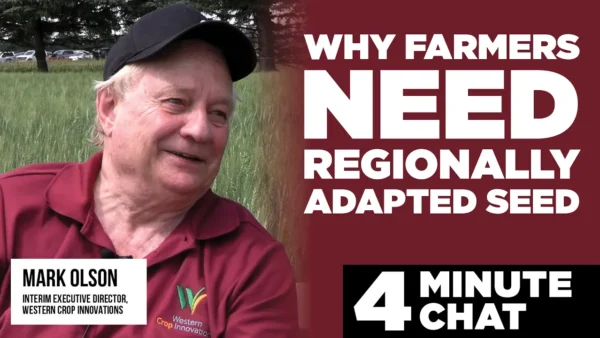
_x000D_
_x000D_
Maintaining Ag’s Positive Outlook_x000D_
_x000D_
 There is optimism in the Canadian plant-based agriculture sector. Attitudes of farmers and the businesses that serve them are more positive than they have been in many years. Prices are strong and are forecast to stay that way for some time. Domestic and international markets are expanding, providing opportunities for farmers and for our sector. After a slight slump, seed exports are up again, and new products are entering the innovation pipeline at an accelerated rate. These products are coming from traditional breeding programs, through trait development, and through new breeding techniques that are not considered to be biotechnology. They will not only benefit farmers by increasing productivity and reducing other input costs, they will deliver nutritional and health benefits for consumers, and will contribute to conservation and environmental protection._x000D_
There is optimism in the Canadian plant-based agriculture sector. Attitudes of farmers and the businesses that serve them are more positive than they have been in many years. Prices are strong and are forecast to stay that way for some time. Domestic and international markets are expanding, providing opportunities for farmers and for our sector. After a slight slump, seed exports are up again, and new products are entering the innovation pipeline at an accelerated rate. These products are coming from traditional breeding programs, through trait development, and through new breeding techniques that are not considered to be biotechnology. They will not only benefit farmers by increasing productivity and reducing other input costs, they will deliver nutritional and health benefits for consumers, and will contribute to conservation and environmental protection._x000D_
_x000D_
I like to think in terms of images, so when it comes to the “innovation pipeline” I think of an actual pipe through which new products flow to our farmer customers. At one end of the pipe are our creative, talented and skilled scientists, geneticists, plant breeders and developers in their labs, greenhouses and test plots, making their first crosses and developing new breeding techniques to deliver improved products to farmers. On the other end are the farmers who need and expect these products to improve productivity and capture new market opportunities in Canada and around the world._x000D_
_x000D_
But this pipeline isn’t a smooth one. It has twists and turns and at points there are clogs that do or can impede the flow of innovation. If the industry doesn’t work together to break the clogs, the optimism for the Canadian seed and agriculture sectors will quickly turn to frustration._x000D_
_x000D_
The first clog is right at the beginning of the pipeline. It’s the value capture clog, created by inadequate tools to generate funds for investment. The challenges for the seed industry will be to increase awareness and support in the farm community and with policy makers for effective tools such as certified seed purchases and the ability to protect intellectual property and enforce IP rights._x000D_
_x000D_
There is another obstruction near the beginning of the pipeline: the human resources clog. A study done for the Canadian Seed Trade Association shows that just to keep up with attrition in the seed industry, we need to hire over 600 new people every year. We need to encourage young people at the beginning of their careers and skilled people in other careers to consider the seed industry in their futures._x000D_
_x000D_
Part way through the pipeline is the regulatory clog. Recent changes to marketing systems and to the variety registration system have started the process to break down this clog, but they have also created expectations. But so many more regulatory changes are required to dissolve the clog. Sticking to my image of the pipeline, increasing pressure from expectations, building behind significant blockages, won’t have a good result._x000D_
_x000D_
At the end of the pipeline is another obstruction. That’s the release obstruction. Asynchronous approvals of new products in markets around the world limit the ability for new products to leave the pipeline, and the absence of policies and frameworks to ensure that new products can coexist without damaging existing and potential markets are likely our biggest challenges._x000D_
_x000D_
For many years, the value chain in agriculture has been fragmented, with the various players pursuing individual goals. That has to change. We all need to work together to achieve our common goals. That will take strong associations backed by informed, engaged and committed members._x000D_
_x000D_
Patty Townsend, CEO, Canadian Seed Trade Association_x000D_
_x000D_
_x000D_
Maintaining Ag’s Positive Outlook_x000D_
_x000D_
 There is optimism in the Canadian plant-based agriculture sector. Attitudes of farmers and the businesses that serve them are more positive than they have been in many years. Prices are strong and are forecast to stay that way for some time. Domestic and international markets are expanding, providing opportunities for farmers and for our sector. After a slight slump, seed exports are up again, and new products are entering the innovation pipeline at an accelerated rate. These products are coming from traditional breeding programs, through trait development, and through new breeding techniques that are not considered to be biotechnology. They will not only benefit farmers by increasing productivity and reducing other input costs, they will deliver nutritional and health benefits for consumers, and will contribute to conservation and environmental protection._x000D_
There is optimism in the Canadian plant-based agriculture sector. Attitudes of farmers and the businesses that serve them are more positive than they have been in many years. Prices are strong and are forecast to stay that way for some time. Domestic and international markets are expanding, providing opportunities for farmers and for our sector. After a slight slump, seed exports are up again, and new products are entering the innovation pipeline at an accelerated rate. These products are coming from traditional breeding programs, through trait development, and through new breeding techniques that are not considered to be biotechnology. They will not only benefit farmers by increasing productivity and reducing other input costs, they will deliver nutritional and health benefits for consumers, and will contribute to conservation and environmental protection._x000D__x000D_
I like to think in terms of images, so when it comes to the “innovation pipeline” I think of an actual pipe through which new products flow to our farmer customers. At one end of the pipe are our creative, talented and skilled scientists, geneticists, plant breeders and developers in their labs, greenhouses and test plots, making their first crosses and developing new breeding techniques to deliver improved products to farmers. On the other end are the farmers who need and expect these products to improve productivity and capture new market opportunities in Canada and around the world._x000D_
_x000D_
But this pipeline isn’t a smooth one. It has twists and turns and at points there are clogs that do or can impede the flow of innovation. If the industry doesn’t work together to break the clogs, the optimism for the Canadian seed and agriculture sectors will quickly turn to frustration._x000D_
_x000D_
The first clog is right at the beginning of the pipeline. It’s the value capture clog, created by inadequate tools to generate funds for investment. The challenges for the seed industry will be to increase awareness and support in the farm community and with policy makers for effective tools such as certified seed purchases and the ability to protect intellectual property and enforce IP rights._x000D_
_x000D_
There is another obstruction near the beginning of the pipeline: the human resources clog. A study done for the Canadian Seed Trade Association shows that just to keep up with attrition in the seed industry, we need to hire over 600 new people every year. We need to encourage young people at the beginning of their careers and skilled people in other careers to consider the seed industry in their futures._x000D_
_x000D_
Part way through the pipeline is the regulatory clog. Recent changes to marketing systems and to the variety registration system have started the process to break down this clog, but they have also created expectations. But so many more regulatory changes are required to dissolve the clog. Sticking to my image of the pipeline, increasing pressure from expectations, building behind significant blockages, won’t have a good result._x000D_
_x000D_
At the end of the pipeline is another obstruction. That’s the release obstruction. Asynchronous approvals of new products in markets around the world limit the ability for new products to leave the pipeline, and the absence of policies and frameworks to ensure that new products can coexist without damaging existing and potential markets are likely our biggest challenges._x000D_
_x000D_
For many years, the value chain in agriculture has been fragmented, with the various players pursuing individual goals. That has to change. We all need to work together to achieve our common goals. That will take strong associations backed by informed, engaged and committed members._x000D_
_x000D_
Patty Townsend, CEO, Canadian Seed Trade Association_x000D_
_x000D_













